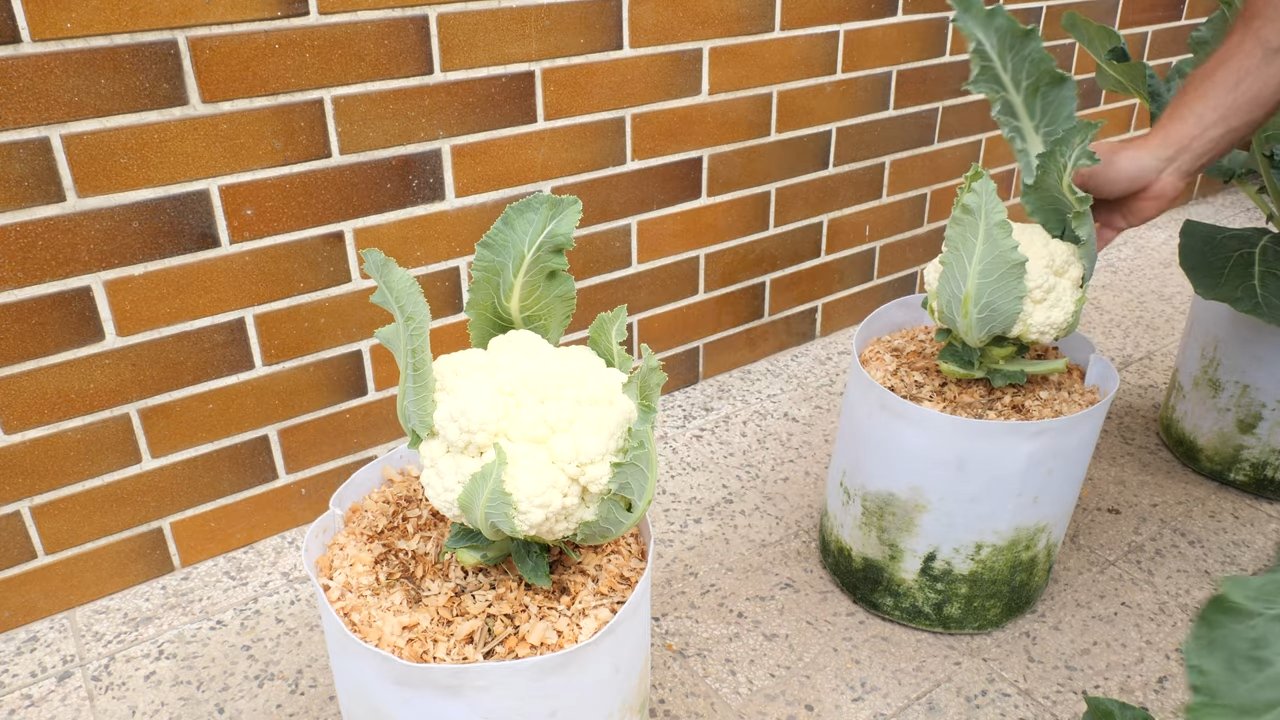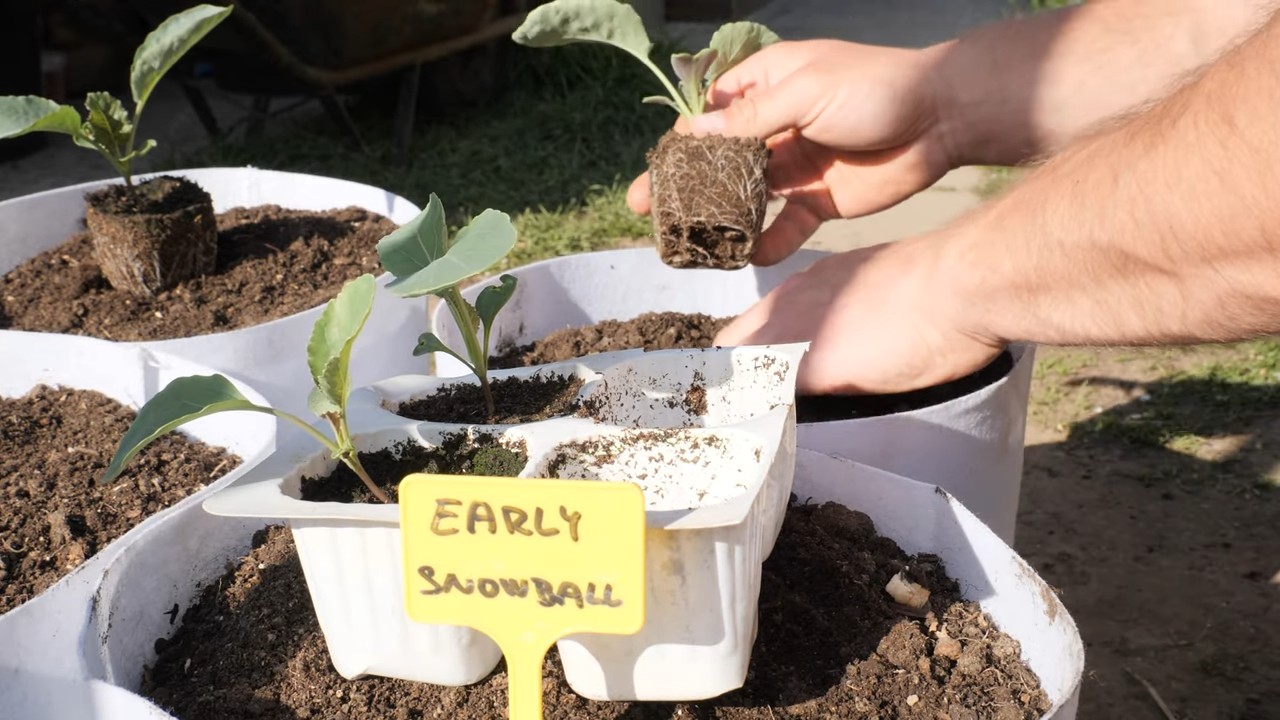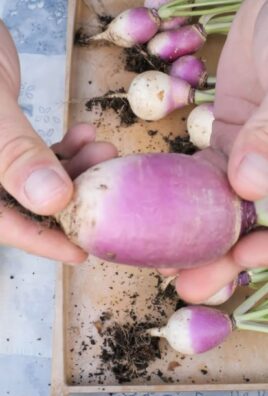Cauliflower container gardening might sound intimidating, but trust me, it’s a surprisingly rewarding and accessible way to grow your own delicious, nutritious veggies, even if you’re short on space! Forget sprawling fields; we’re bringing the farm to your patio, balcony, or even your sunny windowsill.
For centuries, cultivating our own food has been a cornerstone of human civilization. From ancient kitchen gardens to the elaborate orangeries of European royalty, the desire to nurture and harvest has been deeply ingrained in our culture. While we might not all have royal estates, the spirit of self-sufficiency lives on, and cauliflower container gardening allows us to tap into that connection with the earth, no matter where we live.
Why should you try this DIY trick? Well, store-bought cauliflower can be expensive and sometimes lacks that fresh, vibrant flavor. Plus, there’s nothing quite like the satisfaction of harvesting something you’ve nurtured from a tiny seedling. This article is packed with simple, step-by-step instructions and clever hacks to help you succeed, even if you’re a complete beginner. We’ll cover everything from choosing the right container and soil to preventing pests and harvesting your beautiful, homegrown cauliflower. Get ready to unleash your inner gardener and enjoy the freshest cauliflower you’ve ever tasted!

Growing Cauliflower in Containers: A Beginner’s Guide
Hey there, fellow gardening enthusiasts! Ever thought about growing cauliflower but felt intimidated by the space requirements? Well, I’m here to tell you that you absolutely CAN grow cauliflower in containers, even if you only have a small balcony or patio. It’s a rewarding experience, and nothing beats the taste of homegrown veggies. Let’s dive into how you can successfully cultivate this cruciferous beauty in pots.
Choosing the Right Container and Soil
First things first, let’s talk about the foundation of your cauliflower garden: the container and the soil. This is crucial for success!
* Container Size: Cauliflower needs room to grow, so opt for a container that’s at least 12 inches in diameter and 12 inches deep. A 5-gallon bucket or a large planter works perfectly. Bigger is generally better, as it gives the roots more space to spread out and access nutrients.
* Drainage: Excellent drainage is non-negotiable. Cauliflower hates sitting in soggy soil, which can lead to root rot. Make sure your container has drainage holes at the bottom. If not, you’ll need to drill some.
* Soil Mix: Forget garden soil! It’s too heavy and compacts easily in containers. Instead, use a high-quality potting mix that’s well-draining and rich in organic matter. I personally love using a mix of compost, peat moss (or coco coir as a sustainable alternative), and perlite. This combination provides good drainage, aeration, and nutrients.
Selecting the Right Cauliflower Variety
Not all cauliflower varieties are created equal, especially when it comes to container gardening. Some are better suited for smaller spaces than others.
* Compact Varieties: Look for cauliflower varieties specifically bred for smaller gardens or containers. Some excellent choices include ‘Snow Crown,’ ‘Early White Hybrid,’ and ‘Cheddar’ (for a fun orange cauliflower!). These varieties tend to be more compact and mature faster.
* Days to Maturity: Consider the “days to maturity” listed on the seed packet. Shorter maturity times are ideal for container gardening, as you’ll be able to harvest your cauliflower sooner.
* Seed Starting vs. Transplants: You can start cauliflower from seed indoors or purchase transplants from a local nursery. Starting from seed gives you more control over the variety, but transplants are a convenient option if you’re short on time or space.
Planting Your Cauliflower
Now for the fun part: getting your cauliflower into its new home!
1. Prepare the Container: Fill your chosen container with the potting mix, leaving about an inch or two of space at the top.
2. Planting Seeds (if starting from seed): Sow seeds about ½ inch deep and 2-3 inches apart. Once the seedlings emerge and have a few true leaves, thin them out, leaving only the strongest seedling in the container.
3. Planting Transplants: Gently remove the cauliflower transplant from its nursery pot. Loosen the roots slightly if they are root-bound. Dig a hole in the potting mix large enough to accommodate the root ball. Place the transplant in the hole, ensuring that the top of the root ball is level with the soil surface.
4. Water Thoroughly: After planting, water the cauliflower thoroughly until water drains out of the drainage holes. This helps settle the soil around the roots.
5. Mulch (Optional): Add a layer of mulch around the base of the cauliflower plant. Mulch helps retain moisture, suppress weeds, and regulate soil temperature. Straw, shredded leaves, or wood chips work well.
Caring for Your Container Cauliflower
Consistent care is key to growing healthy and productive cauliflower in containers.
* Watering: Cauliflower needs consistent moisture, especially during hot weather. Water deeply whenever the top inch of soil feels dry to the touch. Avoid overwatering, as this can lead to root rot. Aim for consistent moisture, not soggy conditions.
* Fertilizing: Cauliflower is a heavy feeder, meaning it needs plenty of nutrients to thrive. Fertilize every 2-3 weeks with a balanced liquid fertilizer, following the instructions on the fertilizer label. You can also amend the soil with compost tea for an organic boost.
* Sunlight: Cauliflower needs at least 6 hours of direct sunlight per day. Place your container in a sunny location where it will receive ample sunlight. If you live in a particularly hot climate, provide some afternoon shade to prevent the plant from overheating.
* Pest Control: Keep an eye out for common cauliflower pests, such as cabbage worms, aphids, and flea beetles. Inspect your plants regularly and take action promptly if you spot any pests. You can handpick pests off the plants, use insecticidal soap, or apply Bacillus thuringiensis (Bt) for cabbage worms.
* Blanching (Optional): Blanching is the process of covering the developing cauliflower head to prevent it from turning yellow or brown. While not essential, blanching can result in a whiter, more visually appealing cauliflower head. To blanch, simply tie the outer leaves of the plant together over the developing head when it reaches about 3 inches in diameter. Secure the leaves with twine or rubber bands.
Harvesting Your Cauliflower
The moment you’ve been waiting for: harvesting your homegrown cauliflower!
1. Check for Maturity: Cauliflower is ready to harvest when the head is firm, compact, and reaches the desired size (usually 6-8 inches in diameter, depending on the variety).
2. Harvesting: Use a sharp knife to cut the cauliflower head from the plant, leaving a few leaves attached to protect the head.
3. Enjoy! Your freshly harvested cauliflower is now ready to be enjoyed in a variety of dishes. Roast it, steam it, mash it, or use it in soups and stews. The possibilities are endless!
Troubleshooting Common Problems
Even with the best care, you might encounter some challenges along the way. Here are some common problems and how to address them:
* Buttoning: This is when the cauliflower head forms prematurely and remains small. It’s often caused by stress, such as lack of water, nutrients, or sunlight. Ensure your cauliflower receives adequate water, fertilizer, and sunlight to prevent buttoning.
* Yellowing Heads: Yellowing heads can be caused by lack of blanching (if you’re growing a white variety) or exposure to too much sunlight. Blanching can help prevent yellowing.
* Root Rot: Root rot is caused by overwatering and poor drainage. Ensure your container has drainage holes and avoid overwatering.
* Pest Infestations: As mentioned earlier, keep an eye out for pests and take action promptly.
Extending Your Cauliflower Season
Want to enjoy homegrown cauliflower for longer? Here are a few tips:
* Succession Planting: Plant new cauliflower seedlings every few weeks to ensure a continuous harvest.
* Fall Planting: In many regions, you can plant cauliflower in the fall for a winter or early spring harvest.
* Cold Frames or Greenhouses: If you live in a cold climate, consider using a cold frame or greenhouse to protect your cauliflower plants from frost and extend the growing season.
Growing cauliflower in containers is a rewarding experience that allows you to enjoy fresh, homegrown vegetables even if you have limited space. With the right container, soil, variety, and care, you can successfully cultivate this delicious and nutritious vegetable on your balcony, patio, or even indoors with grow lights. So, grab your gardening gloves and get ready to enjoy the fruits (or rather, vegetables!) of your labor. Happy gardening!

Conclusion
So, there you have it! Transforming your patio, balcony, or even a sunny corner of your yard into a thriving cauliflower patch is not only achievable but incredibly rewarding. We’ve walked you through the simple steps of container gardening for cauliflower, demystifying the process and proving that you don’t need acres of land to enjoy the satisfaction of harvesting your own fresh, delicious produce.
Why is this DIY trick a must-try? Because it puts you in control. You control the soil quality, ensuring your cauliflower receives the nutrients it needs to flourish. You control the watering, preventing overwatering or underwatering, common pitfalls in traditional gardening. And you control the pest management, keeping those pesky critters at bay without resorting to harsh chemicals. Plus, let’s be honest, there’s something undeniably cool about growing your own food, especially something as substantial and versatile as cauliflower.
But the beauty of container gardening lies in its adaptability. Feel free to experiment with different cauliflower varieties. While we’ve focused on standard white cauliflower, consider trying purple, orange, or even Romanesco varieties for a splash of color and unique flavor profiles. You can also adjust the size of your container based on the space you have available. Just remember that larger containers generally lead to larger, healthier heads of cauliflower.
Don’t be afraid to get creative with companion planting. Marigolds can help deter pests, while herbs like rosemary and thyme can add a fragrant touch to your container garden. Consider adding a layer of mulch to help retain moisture and suppress weeds. And if you live in a particularly hot climate, providing some afternoon shade can prevent your cauliflower from bolting (going to seed prematurely).
Ultimately, the best way to learn is by doing. So, gather your supplies, follow our guide, and embark on your own cauliflower container gardening adventure. We’re confident that you’ll be amazed by the results. Imagine the satisfaction of serving a dish made with cauliflower you grew yourself – a testament to your green thumb and your commitment to fresh, healthy eating.
We’re eager to hear about your experiences! Share your photos, tips, and challenges in the comments below. Let’s build a community of container gardening enthusiasts and inspire others to embrace the joy of growing their own food. What variety of cauliflower did you choose? What challenges did you face, and how did you overcome them? Your insights could be invaluable to other aspiring gardeners. So, get planting, get sharing, and get ready to enjoy the delicious rewards of your own homegrown cauliflower!
Frequently Asked Questions (FAQ)
What is the best size container for growing cauliflower?
The ideal container size for growing cauliflower is at least 5 gallons, but a 10-gallon container is even better. This provides ample space for the roots to develop and supports the growth of a healthy, substantial head of cauliflower. Smaller containers may restrict root growth, leading to smaller heads or even stunted plants. Remember, the larger the container, the more stable the growing environment will be, reducing the risk of the plant drying out too quickly or becoming root-bound.
What type of soil should I use for container gardening cauliflower?
Use a high-quality potting mix specifically formulated for vegetables. Avoid using garden soil, as it can be too heavy and compacted for container gardening. A good potting mix will provide adequate drainage, aeration, and nutrients for your cauliflower plants. You can also amend the potting mix with compost or other organic matter to further enrich the soil and improve its water-holding capacity. Look for a potting mix that contains ingredients like peat moss, perlite, and vermiculite.
How often should I water my container-grown cauliflower?
Water your cauliflower regularly, especially during hot and dry weather. The soil should be kept consistently moist, but not waterlogged. Check the soil moisture level daily by sticking your finger about an inch into the soil. If it feels dry, it’s time to water. Water deeply, allowing the water to drain out of the bottom of the container. Avoid overhead watering, as this can increase the risk of fungal diseases. Consider using a soaker hose or drip irrigation system to deliver water directly to the roots.
How much sunlight does cauliflower need?
Cauliflower requires at least 6 hours of direct sunlight per day to thrive. Choose a location for your container garden that receives plenty of sunlight throughout the day. If you live in a particularly hot climate, providing some afternoon shade can help prevent the cauliflower from bolting. You can use shade cloth or move the container to a shadier location during the hottest part of the day.
How do I fertilize my container-grown cauliflower?
Cauliflower is a heavy feeder, so regular fertilization is essential for healthy growth. Start fertilizing your plants about two weeks after transplanting them into the container. Use a balanced fertilizer specifically formulated for vegetables, following the instructions on the package. You can also use organic fertilizers like compost tea or fish emulsion. Fertilize every two to three weeks throughout the growing season. Avoid over-fertilizing, as this can lead to excessive foliage growth at the expense of head development.
How do I prevent pests and diseases in my container garden?
Regularly inspect your cauliflower plants for signs of pests or diseases. Common pests that affect cauliflower include aphids, cabbage worms, and flea beetles. You can control these pests with insecticidal soap, neem oil, or by handpicking them off the plants. To prevent diseases, ensure good air circulation around the plants and avoid overhead watering. If you notice any signs of disease, such as yellowing leaves or spots, remove the affected leaves immediately and treat the plant with a fungicide. Companion planting with marigolds can also help deter pests.
How long does it take for cauliflower to mature in a container?
The time it takes for cauliflower to mature depends on the variety and growing conditions. Generally, it takes about 70 to 90 days from transplanting to harvest. You’ll know your cauliflower is ready to harvest when the head is firm, compact, and about 6 to 8 inches in diameter. Check the seed packet or plant tag for specific information on the maturity time for your chosen variety.
Can I grow cauliflower in containers indoors?
While it’s possible to grow cauliflower indoors, it can be challenging. Cauliflower requires a lot of sunlight, so you’ll need to provide supplemental lighting if you don’t have a sunny window. You’ll also need to ensure good air circulation and maintain a consistent temperature. Container gardening for cauliflower is generally more successful outdoors, where the plants can receive ample sunlight and fresh air.
What are some good companion plants for cauliflower in containers?
Several plants can be grown alongside cauliflower in containers to help deter pests, attract beneficial insects, and improve the overall health of the plants. Some good companion plants for cauliflower include:
* Marigolds: Deter pests like nematodes and aphids.
* Rosemary and Thyme: Repel cabbage moths and other pests.
* Nasturtiums: Attract aphids away from the cauliflower.
* Garlic and Onions: Repel a variety of pests.
* Lettuce and Spinach: Provide ground cover and help retain moisture.
What should I do if my cauliflower starts to bolt (go to seed)?
Bolting is when a plant prematurely flowers and goes to seed. This can happen if the cauliflower is exposed to stress, such as extreme heat or cold, or if it’s not watered properly. Once a cauliflower plant starts to bolt, the head will become loose and bitter. Unfortunately, there’s not much you can do to reverse bolting. To prevent bolting, ensure your cauliflower plants receive consistent watering, adequate sunlight, and protection from extreme temperatures. Choose bolt-resistant varieties if you live in an area with unpredictable weather.




Leave a Comment